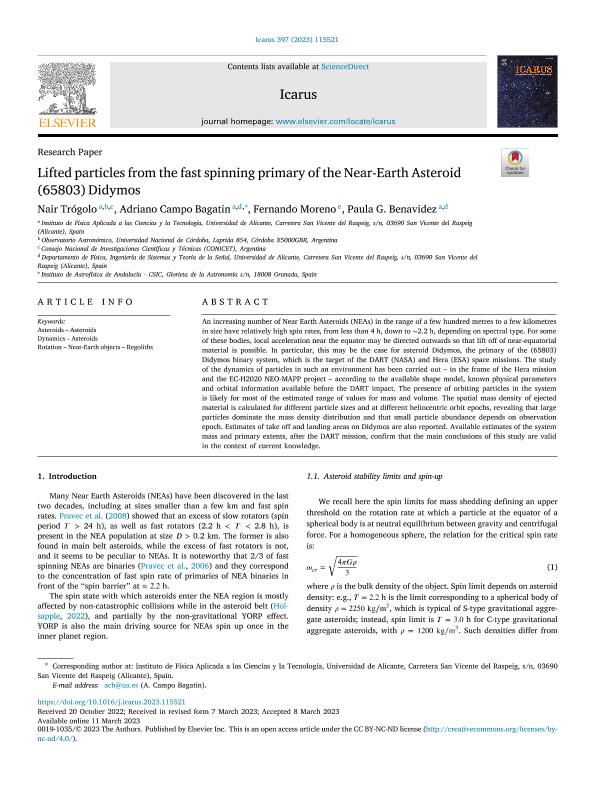Mostrar el registro sencillo del ítem
dc.contributor.author
Trógolo, Nair Elisa

dc.contributor.author
Campo Bagatin, Adriano
dc.contributor.author
Moreno, Fernando
dc.contributor.author
Benavidez, Paula G.
dc.date.available
2023-12-06T14:22:16Z
dc.date.issued
2023-03
dc.identifier.citation
Trógolo, Nair Elisa; Campo Bagatin, Adriano; Moreno, Fernando; Benavidez, Paula G.; Lifted particles from the fast spinning primary of the Near-Earth Asteroid (65803) Didymos; Academic Press Inc Elsevier Science; Icarus; 397; 3-2023; 1-12
dc.identifier.issn
0019-1035
dc.identifier.uri
http://hdl.handle.net/11336/219476
dc.description.abstract
An increasing number of Near Earth Asteroids (NEAs) in the range of a few hundred metres to a few kilometres in size have relatively high spin rates, from less than 4 h, down to ∼2.2 h, depending on spectral type. For some of these bodies, local acceleration near the equator may be directed outwards so that lift off of near-equatorial material is possible. In particular, this may be the case for asteroid Didymos, the primary of the (65803) Didymos binary system, which is the target of the DART (NASA) and Hera (ESA) space missions. The study of the dynamics of particles in such an environment has been carried out – in the frame of the Hera mission and the EC-H2020 NEO-MAPP project – according to the available shape model, known physical parameters and orbital information available before the DART impact. The presence of orbiting particles in the system is likely for most of the estimated range of values for mass and volume. The spatial mass density of ejected material is calculated for different particle sizes and at different heliocentric orbit epochs, revealing that large particles dominate the mass density distribution and that small particle abundance depends on observation epoch. Estimates of take off and landing areas on Didymos are also reported. Available estimates of the system mass and primary extents, after the DART mission, confirm that the main conclusions of this study are valid in the context of current knowledge.
dc.format
application/pdf
dc.language.iso
eng
dc.publisher
Academic Press Inc Elsevier Science

dc.rights
info:eu-repo/semantics/openAccess
dc.rights.uri
https://creativecommons.org/licenses/by-nc-nd/2.5/ar/
dc.subject
ASTEROIDS
dc.subject
DYNAMICS
dc.subject
ROTATION
dc.subject
NEAR-EARTH OBJECTS
dc.subject
REGOLITHS
dc.subject.classification
Astronomía

dc.subject.classification
Ciencias Físicas

dc.subject.classification
CIENCIAS NATURALES Y EXACTAS

dc.title
Lifted particles from the fast spinning primary of the Near-Earth Asteroid (65803) Didymos
dc.type
info:eu-repo/semantics/article
dc.type
info:ar-repo/semantics/artículo
dc.type
info:eu-repo/semantics/publishedVersion
dc.date.updated
2023-12-05T15:00:21Z
dc.journal.volume
397
dc.journal.pagination
1-12
dc.journal.pais
Estados Unidos

dc.description.fil
Fil: Trógolo, Nair Elisa. Universidad Nacional de Córdoba. Observatorio Astronómico de Córdoba; Argentina. Universidad de Alicante; España. Consejo Nacional de Investigaciones Científicas y Técnicas. Centro Científico Tecnológico Conicet - Córdoba; Argentina
dc.description.fil
Fil: Campo Bagatin, Adriano. Universidad de Alicante; España
dc.description.fil
Fil: Moreno, Fernando. Consejo Superior de Investigaciones Científicas; España
dc.description.fil
Fil: Benavidez, Paula G.. Universidad de Alicante; España
dc.journal.title
Icarus

dc.relation.alternativeid
info:eu-repo/semantics/altIdentifier/doi/http://dx.doi.org/10.1016/j.icarus.2023.115521
Archivos asociados
